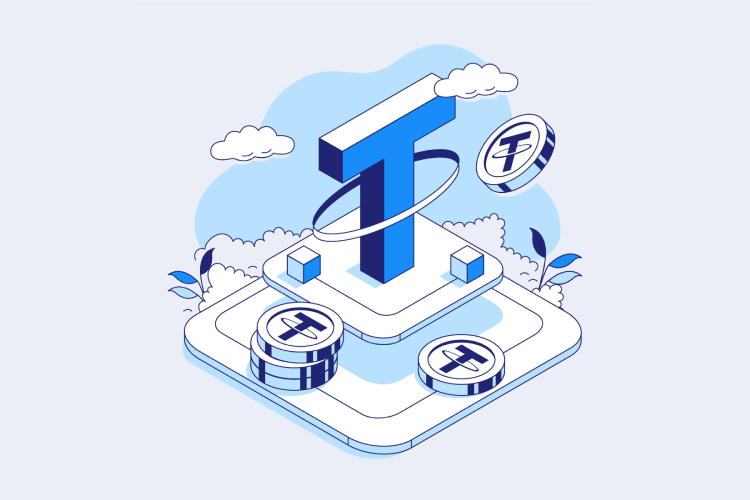Table of Contents
Key Takeaways
- Tether (USDT) has the potential to bridge the gap between the traditional financial system and the crypto industry.
- Stablecoins like Tether (USDT) are designed to maintain a stable value relative to a particular asset, such as the US dollar.
- The risks associated with stablecoins include the potential for their value to become disconnected from the asset they are pegged to and the lack of regulatory oversight
- Tether (USDT) can be used for everyday transactions, especially in the world of cryptocurrencies, but may not be as widely accepted as traditional fiat currencies
- Tether (USDT) has faced controversies and concerns about its transparency but remains an important tool for traders, investors, and users of cryptocurrencies.
- Tether (USDT) has the potential to disrupt the traditional financial industry and impact the demand for traditional fiat currencies and the role of central banks in the global financial system.
Introduction
Cryptocurrencies have exploded in popularity over the last decade, but their price volatility has made them less appealing as an everyday method of payment. This is where stablecoins come in, with Tether (USDT) being one of the most widely used stablecoins in the crypto industry.
Definition of Tether (USDT)
Tether (USDT) is a stablecoin that is pegged to the US dollar. In other words, for every USDT issued, there is a corresponding US dollar held in reserve. This ensures that the value of Tether (USDT) remains stable and is not subject to the same volatility as other cryptocurrencies.
Brief history of Tether (USDT)
Tether (USDT) was launched in 2014 by Tether Limited, a company based in Hong Kong. It was marketed an alternative to traditional banking methods, but quickly gained popularity among as a means of protection against the price volatility of other cryptocurrencies. Since its launch, Tether (USDT) has grown to become one of the most widely used stablecoins.
Significance of Tether (USDT) in the crypto industry
Tether (USDT) has played a significant role in the crypto industry by providing stability to traders and investors. Tether has also become a key component of the decentralized finance (DeFi) ecosystem, with many DeFi protocols using it as a means of exchange and liquidity.

Understanding Stablecoins
Stablecoins are cryptocurrencies that are designed to maintain a stable value relative to a particular asset or basket of assets. Stablecoins are most commonly pegged to the price of the US dollar.
What are stablecoins?
Stablecoins were developed as a solution to the high volatility of traditional cryptocurrencies like Bitcoin and Ethereum. The price of these cryptocurrencies can fluctuate quite drastically in a short space of time, which makes them unappetizing to some for everyday use.
Stablecoins aim to provide the benefits of cryptocurrencies, such as speed and low transaction fees, while also maintaining a stable value. This makes them more appealing for everyday use.
Different types of stablecoins
There are several different types of stablecoins, each with its own method of achieving stability. The most common types include:
- Fiat-backed stablecoins: These stablecoins are backed by a reserve of fiat currency, such as the US dollar or euro. For every stablecoin issued, there is a corresponding amount of fiat currency held in reserve.
- Crypto-backed stablecoins: These stablecoins are backed by a reserve of other cryptocurrencies, such as Bitcoin or Ethereum. The value of the stablecoin is maintained by ensuring that the value of the reserve is always greater than the value of the underlying asset.
- Algorithmic stablecoins: These stablecoins use algorithms to maintain their stability. For example, the algorithm may adjust the supply of the stablecoin in response to changes in demand to maintain a stable price.
Advantages and disadvantages of stablecoins
The main advantage of stablecoins is their stability. This makes them a more appealing option for everyday use, as well as for traders and investors seeking shelter from volatility. Stablecoins also offer the benefits of cryptocurrencies, such as low transaction fees and fast transaction times.
However, stablecoins also have some disadvantages. For example, fiat-backed stablecoins are only as stable as the fiat currency they are backed by. If the value of the fiat currency were to decrease significantly, the value of the stablecoin would also be affected. Additionally, some stablecoins may not be fully transparent about their reserves, which can lead to concerns about their stability.
Stablecoins are an important development in the world of cryptocurrencies, offering a stable and more reliable option for those looking to use or invest in cryptocurrencies
Tether (USDT) Explained
Let’s take a closer look at how Tether (USDT) works.
How Tether (USDT) works
Tether (USDT) works by maintaining a reserve of US dollars that is equivalent to the number of USDT tokens in circulation. This means that for every USDT token issued, there is a corresponding US dollar held in reserve.
The reserve is managed by Tether Limited, the company behind Tether (USDT). The company claims that the reserve is audited regularly by independent third-party firms to ensure that it contains enough assets to back the tokens in circulation.
Tether (USDT) can be purchased and redeemed for US dollars through a number of cryptocurrency exchanges. This allows users to exchange their cryptocurrency for a stable asset without leaving the cryptocurrency ecosystem.
Advantages of Tether (USDT)
- Stability: Tether (USDT) is pegged to the US dollar, which makes it less volatile than other cryptocurrencies and provides stability to users.
- Efficiency: Tether (USDT) offers fast transaction times and low transaction fees, making it a more efficient option for transferring funds between cryptocurrency exchanges.
- Accessibility: Tether (USDT) can be purchased and redeemed for US dollars through a number of cryptocurrency exchanges, allowing users to exchange their cryptocurrency for a stable asset without leaving the cryptocurrency ecosystem.
- Hedging: Tether (USDT) provides a means for traders and investors to hedge against volatility.
- Transparency: Tether Limited claims to regularly audit its reserve of US dollars to ensure that it contains enough assets to back the tokens in circulation, providing a level of transparency to users.
- Liquidity: Tether (USDT) is one of the most widely used stablecoins in the cryptocurrency market, which provides liquidity to users who want to buy or sell their USDT tokens.
- Access to DeFi: Tether (USDT) is used in many DeFi protocols, allowing users to access financial services without the need for traditional financial institutions.
Controversies surrounding Tether (USDT)
Tether (USDT) has been the subject of several controversies over the years. One of the main controversies is whether or not Tether Limited actually holds enough reserves to back all of the USDT tokens in circulation. Some critics have raised concerns that Tether Limited is not fully transparent about its reserves, which could lead to instability in the cryptocurrency market if investors were to lose confidence in Tether (USDT).
Another controversy surrounding Tether (USDT) is its relationship with the cryptocurrency exchange Bitfinex. Tether Limited and Bitfinex share some of the same executives, which has led to concerns about conflicts of interest and the potential for market manipulation.
The Role of Tether (USDT) in the Crypto Industry
Tether (USDT) has established itself as an integral part of the crypto industry. Let’s explore the role of Tether (USDT) in the crypto industry, including its relationship with Bitcoin (BTC), its impact on the crypto market, and its role in decentralized finance (DeFi).
Tether (USDT) and Bitcoin (BTC)
Tether (USDT) has played a significant role in the relationship between Bitcoin (BTC) and the traditional financial system.
Tether (USDT) has become a popular option for traders and investors who want to hedge against the volatility of BTC. By using USDT instead of BTC, they can avoid the risk of price fluctuations while still remaining within the cryptocurrency ecosystem.
Moreover, Tether (USDT) has also become an important tool for trading BTC on cryptocurrency exchanges. Many exchanges do not allow users to trade BTC for traditional fiat currencies, but they do allow users to trade BTC for USDT. This has made Tether (USDT) an important part of the Bitcoin trading ecosystem.
Tether (USDT) and the Crypto Market
Tether (USDT) has had a significant impact on the crypto market as a whole. Its stability has made it a popular option for traders and investors who want to avoid the volatility of other cryptocurrencies, which has led to its widespread adoption in the industry.
However, Tether (USDT) has also been criticized for its potential impact on the crypto market. Some critics have raised concerns that the widespread use of Tether (USDT) could lead to market manipulation, as it could be used to artificially inflate the prices of other cryptocurrencies.
Tether (USDT) and Decentralized Finance (DeFi)
Tether (USDT) has also become an important tool in the world of decentralized finance (DeFi). DeFi protocols allow users to access financial services without the need for traditional financial institutions.
Many DeFi protocols use Tether (USDT) as a means of exchange and liquidity. By using Tether (USDT) instead of traditional fiat currencies, users can access DeFi protocols while remaining within the cryptocurrency ecosystem.
Moreover, Tether (USDT) has also become an important tool for yield farming, which is a popular DeFi strategy for earning interest on cryptocurrency holdings. By providing liquidity to DeFi protocols in exchange for interest payments, users can earn a yield on their cryptocurrency holdings.
Tether (USDT) has played a significant role in the crypto industry, from its relationship with Bitcoin (BTC) to its impact on the crypto market and its role in decentralized finance (DeFi). Its stability and efficiency have made it an attractive option for many users.
Final Thoughts
Tether (USDT) has the potential to continue to play a significant role in the future of the crypto industry by bridging the gap between the traditional financial system and the world of cryptocurrencies. Its relationship with Bitcoin (BTC) has already demonstrated its potential to provide stability to the cryptocurrency market.
Tether (USDT) has had a significant impact on the crypto industry, providing stability and efficiency to users and becoming an integral part of the cryptocurrency ecosystem. While it has faced controversies and concerns about its transparency, it remains an important tool for traders, investors, and users of cryptocurrencies.
As the crypto industry continues to evolve, Tether (USDT) is likely to play an increasingly important role. Its stability and efficiency make it an attractive option for those looking to use or invest in cryptocurrencies, and its potential to bridge the gap between the traditional financial system and the crypto industry make it an exciting development for the future of finance.
Tether FAQs
How do stablecoins compare to fiat currencies?
Stablecoins are designed to maintain a stable value relative to a particular asset, such as the US dollar. This makes them more similar to fiat currencies than other cryptocurrencies, which can be subject to high volatility.
However, stablecoins are not the same as fiat currencies, as they are not issued by a central bank and are not legal tender. This means that they may not be accepted by all merchants or institutions
What are the risks associated with stablecoins?
One of the main risks associated with stablecoins is the potential for their value to become disconnected from the asset they are pegged to. For example, if the reserve backing a stablecoin is not properly managed or audited, the stablecoin’s value could become unstable.
Additionally, stablecoins are not regulated in the same way that fiat currencies are, which means that users may not have the same legal protections.
How has Tether (USDT) impacted the traditional financial industry?
Tether (USDT) has the potential to disrupt the traditional financial industry by providing a stable and efficient means of transferring value without the need for traditional banking methods.
Moreover, the widespread use of stablecoins like Tether (USDT) could also impact the demand for traditional fiat currencies and the role of central banks in the global financial system
Can Tether (USDT) be used for everyday transactions?
Yes, Tether (USDT) can be used for everyday transactions, especially in the world of cryptocurrencies. It can be used to purchase goods and services from merchants who accept Tether (USDT) as payment. However, it is important to note that not all merchants or institutions accept Tether (USDT) as payment, so it may not be as widely accepted as traditional fiat currencies.








